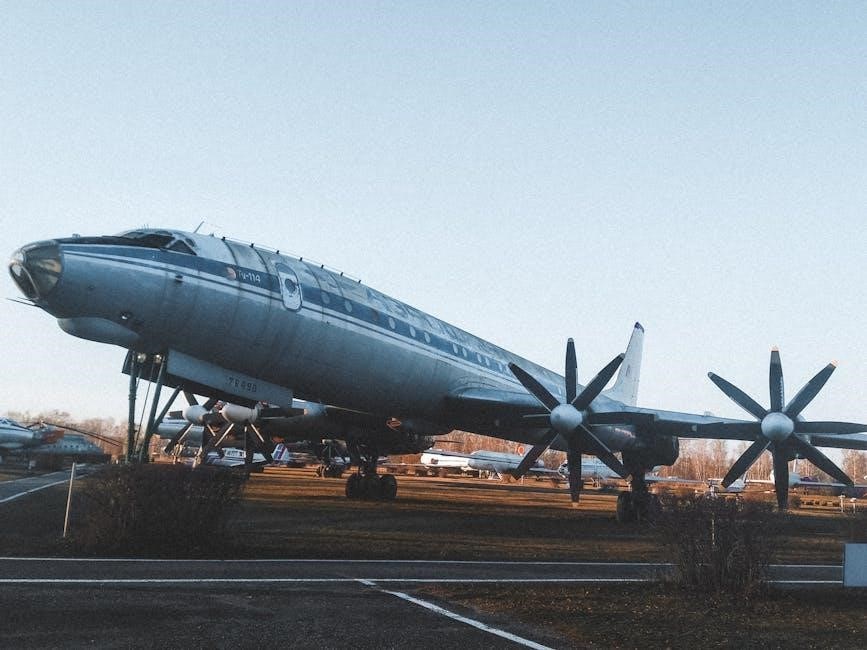
stick and rudder pdf
Stick and Rudder: An Explanation of the Art of Flying, written by Wolfgang Langewiesche in 1944, is a seminal work in aviation literature․ It provides a detailed analysis of flight mechanics, focusing on the stick and rudder controls, and has remained a cornerstone of pilot education for decades․
This timeless guide is widely regarded for its clarity and depth, offering practical insights into the principles of flight․ Its availability in PDF format has made it accessible to modern pilots, ensuring its continued relevance in aviation training and practice․
Overview of the Book
Stick and Rudder: An Explanation of the Art of Flying is a seminal aviation textbook written by Wolfgang Langewiesche and first published in 1944․ The book is renowned for its detailed yet accessible explanation of flight mechanics, focusing on the relationship between an aircraft’s controls and its behavior in the air․ It delves into the fundamentals of aerodynamics, the four forces of flight, and the precise use of the stick, rudder, and throttle․ Langewiesche’s clear and concise writing style makes complex concepts understandable, making it a valuable resource for both student pilots and experienced aviators․ The book has remained in print for over 75 years, underscoring its timeless relevance in aviation education․ Its availability in PDF format has further enhanced its accessibility for modern pilots․
Author Background: Wolfgang Langewiesche
Wolfgang Langewiesche, a renowned aviation expert, pilot, and instructor, is best known for his iconic book Stick and Rudder․ Born in 1907, Langewiesche was deeply passionate about flight and dedicated his career to understanding and teaching the art of flying․ His unique ability to simplify complex aerodynamic principles made him a respected figure in aviation education․ Stick and Rudder, first published in 1944, reflects his extensive experience as a pilot and instructor, offering practical insights into flight mechanics and control techniques․ Langewiesche’s work has become a cornerstone of aviation literature, influencing generations of pilots and remaining a standard reference for flight training․ His legacy endures through the timeless wisdom shared in his writings․
Significance of the Book in Aviation
Stick and Rudder holds a revered place in aviation literature as the first precise analysis of the art of flying․ Its continuous publication since 1944 underscores its enduring relevance․ The book bridges the gap between theoretical aerodynamics and practical flight techniques, making it an indispensable resource for pilots․ Langewiesche’s clear explanations of flight mechanics, such as the angle of attack and control surfaces, have empowered pilots to better understand and command their aircraft․ Its influence extends beyond training, shaping airmanship and fostering safer, more efficient flying practices․ As a result, Stick and Rudder remains a cornerstone of aviation education and a testament to Langewiesche’s profound impact on the field․

The Principles of Flight Explained
The book delves into the fundamental principles of flight, including lift, thrust, drag, and weight, explaining how they interact to enable controlled, sustained aviation․ Langewiesche’s insights into aerodynamics and aircraft behavior provide a solid foundation for understanding flight mechanics, emphasizing the importance of angle of attack and airfoil dynamics in generating lift․ This section is crucial for pilots to grasp the physics behind flying, making it an essential component of aviation education․
The Four Forces of Flight
The four forces of flight—lift, weight, thrust, and drag—are meticulously explained in “Stick and Rudder․” Langewiesche emphasizes how these forces interact to achieve balanced flight․ Lift, generated by airfoils, opposes weight, while thrust from engines overcomes drag․ Understanding this equilibrium is essential for pilots to control aircraft effectively․ Langewiesche’s detailed analysis provides a clear, practical explanation of these fundamental principles, making complex aerodynamics accessible to both novice and experienced aviators․ This section is a cornerstone of the book, offering insights that enhance flight safety and proficiency․
Understanding Angle of Attack
Wolfgang Langewiesche’s “Stick and Rudder” provides a thorough explanation of the angle of attack (AoA), a critical factor in generating lift․ The AoA is the angle between the oncoming airflow and the wing’s chord line․ Langewiesche emphasizes that increasing the AoA enhances lift up to a point, beyond which airflow separates, causing a stall․ He illustrates how pilots must precisely control the AoA to maintain efficient flight, especially during takeoff, climb, and landing․ This concept is central to mastering the art of flying, as described in the book, and is essential for understanding how aircraft behave under various conditions․ Langewiesche’s practical insights make this complex aerodynamic principle accessible to all pilots․

Role of Airfoil in Lift Generation
The airfoil, a wing’s cross-sectional shape, is crucial for lift generation․ Its curved upper surface and flatter lower surface direct airflow such that air moves faster over the top, creating lower pressure according to Bernoulli’s principle․ This pressure difference generates lift․ The angle of attack, the angle between the wing and oncoming air, affects lift: increasing it enhances lift up to a stall point․ Airfoil design varies; some are optimized for speed, others for maneuverability․ Cambered surfaces enhance lift by directing airflow․ Control surfaces like flaps and slats modify the airfoil’s shape to adjust lift during takeoff, landing, or cruising․ Airfoil efficiency varies with altitude and speed, but modern designs maintain performance across regimes․ Historical advancements in airfoil technology, aided by computational tools, have improved lift and overall aircraft efficiency․ Pilots control lift through stick and rudder, affecting the airfoil’s angle and camber, essential for managing lift in various flight conditions․

Aircraft Control Surfaces
Aircraft control surfaces, such as ailerons, elevators, and rudder, enable pilots to control roll, pitch, and yaw․ They are essential for maintaining stability and maneuverability during flight․
Function of Ailerons, Elevators, and Rudder
The ailerons, located on the trailing edges of the wings, control roll by creating differential lift between the wings․ When the pilot moves the stick left or right, the ailerons on one wing rise while those on the other wing lower, inducing the aircraft to roll in the desired direction․ The elevators, positioned on the horizontal stabilizer, manage pitch by altering the angle of attack of the tail section, allowing the pilot to climb or descend․ The rudder, on the vertical stabilizer, controls yaw by pushing air sideways, enabling directional control during takeoff, landing, and flight․
These control surfaces work harmoniously to maintain balanced flight, ensuring precise and efficient aircraft handling․ Their proper use is fundamental to mastering the art of flying, as emphasized in “Stick and Rudder PDF․”
Primary and Secondary Flight Controls
In aviation, primary flight controls are essential for maintaining aircraft stability and maneuverability․ Ailerons, elevators, and rudder are classified as primary controls, directly influencing roll, pitch, and yaw․ Secondary controls, such as flaps and trim tabs, enhance performance but are not critical for basic flight․ The distinction between these controls is crucial for pilots to understand, as primary controls require precise handling, while secondary controls aid in optimizing flight characteristics․ This balance ensures efficient and safe aircraft operation, as detailed in “Stick and Rudder PDF,” which provides comprehensive insights into the mechanics and techniques of flight․

The Role of the Stick in Flight
The stick, or control yoke, is central to aircraft control, governing roll and pitch through ailerons and elevators․ Its precise movements translate directly to aircraft responses, ensuring balanced flight and maneuverability․ Stick and Rudder PDF emphasizes the importance of mastering these controls for safe and efficient flying, as detailed in its comprehensive guide to flight mechanics and techniques․
Stick Movements and Their Effects
Movement of the stick directly influences an aircraft’s orientation and performance․ Pushing the stick forward lowers the nose, increasing speed, while pulling it back raises the nose, slowing the aircraft․ Moving the stick left or right rolls the aircraft, directing it toward the desired direction․ These actions engage the ailerons and elevators, which alter wing angles and control roll and pitch․ Precise stick movements are crucial for maintaining balanced flight, especially during climbs, turns, and descents․ Stick and Rudder PDF emphasizes mastering these movements, as they are fundamental to safe and efficient flying, ensuring smooth transitions and maintaining control in various flight conditions․
Coordination of Controls for Balanced Flight
Coordination of the stick and rudder is essential for achieving balanced flight․ The stick controls roll and pitch, while the rudder manages yaw, ensuring directional alignment․ Proper coordination prevents unwanted slips or skids, which can lead to loss of lift․ In turns, the stick initiates roll, and the rudder adjusts yaw to maintain a steady heading․ This harmonious use of controls is critical during climbs, descents, and straight flight․ Stick and Rudder PDF highlights the importance of this coordination, emphasizing how it enhances stability and control, making flight safer and more efficient․ Mastery of these techniques is vital for pilots to handle various flight scenarios effectively․

The Role of the Rudder in Flight
The rudder is crucial for directional control in flight, managing yaw to maintain alignment․ Essential during takeoffs, landings, and maneuvers, it ensures balanced flight by countering adverse forces․
Rudder Pedal Controls and Their Importance
Rudder pedals are essential for controlling yaw, enabling directional stability․ They are operated by the pilot’s feet, providing precise control during various flight phases․ The rudder’s role in maintaining directional alignment is vital, especially during takeoffs and landings, where deviations can lead to loss of control․ Proper use of rudder pedals ensures balanced flight by countering adverse yaw and maintaining heading․ In coordinated flight, the rudder works in harmony with the stick, optimizing aircraft performance and safety․ Mastery of rudder pedal controls is fundamental for pilots, as it directly impacts the aircraft’s responsiveness and overall flight dynamics․ Understanding their importance is crucial for effective airmanship․
Directional Control During Takeoff and Landing
Directional control is critical during takeoff and landing, where maintaining heading alignment is essential․ The rudder plays a pivotal role in countering adverse yaw and ensuring the aircraft tracks a straight path․ During takeoff, proper rudder input prevents drift and keeps the nose aligned with the runway․ On landing, directional control is vital to avoid lateral deviations that could lead to loss of directional control․ Crosswinds further emphasize the need for precise rudder management to maintain ground track․ Improper rudder technique can lead to mishandling, making it crucial for pilots to master these skills․ Effective use of rudder ensures safety and precision in these critical phases of flight․

Phases of Flight
Phases of flight include takeoff, climb, cruise, descent, and landing․ Each requires precise control and understanding of aircraft behavior, as detailed in Stick and Rudder․
Takeoff Techniques
Takeoff is a critical phase requiring precise coordination of stick and rudder․ According to Stick and Rudder, pilots must align the aircraft with the runway centerline and advance the throttle smoothly․ As speed increases, gentle stick back-pressure lifts the nose, reducing drag․ Once airborne, the aircraft transitions to a climb attitude, maintaining optimal pitch for performance․ Langewiesche emphasizes the importance of rudder control during rotation to counteract any lateral drift caused by propeller torque․ Proper aileron input ensures wings remain level, preventing unwanted rolls․ The technique described in the book focuses on balancing power, pitch, and yaw for a safe and efficient takeoff, highlighting the interconnected roles of flight controls․ This method has been widely adopted as a standard approach in aviation training, ensuring consistency across various aircraft types․
Climb and Cruise Procedures
Stick and Rudder details the importance of proper climb and cruise techniques for efficient flight․ Following takeoff, pilots must establish a climb attitude by adjusting pitch and power to maintain optimal airspeed and rate of ascent․ Langewiesche emphasizes the need to balance the four forces of flight—lift, weight, thrust, and drag—during this phase․ Once reaching cruising altitude, the aircraft transitions to a level flight attitude․ Power settings are adjusted to reduce fuel consumption while maintaining desired airspeed․ The rudder plays a crucial role in maintaining directional control, countering any drift caused by wind or propeller torque․ These procedures highlight the practical application of flight mechanics, ensuring safe and efficient progression from climb to cruise․
Descent and Approach Strategies
Stick and Rudder provides comprehensive guidance on descent and approach strategies, essential for safe and controlled landings․ Langewiesche explains that a well-planned descent begins with gradual power reduction and pitch adjustment to maintain airspeed while descending․ The relationship between altitude and airspeed is crucial, as excessive speed can complicate approach․ Configuring flaps and landing gear at appropriate stages ensures optimal control․ Directional stability is maintained using the rudder, especially during crosswind conditions․ The book emphasizes the importance of visual references and precise control inputs, ensuring alignment with the runway․ These techniques underscore the importance of airmanship in executing smooth transitions from cruising altitude to touchdown, making Stick and Rudder an indispensable resource for pilots․
Landing Techniques
Stick and Rudder delves into the nuances of landing, emphasizing precise control of airspeed, pitch, and rudder alignment․ Langewiesche stresses that a successful landing begins with a stabilized approach, where the aircraft is configured properly and aligned with the runway․ The book highlights the importance of maintaining the optimal angle of attack to avoid stalls and ensure a smooth touchdown․ Rudder control is critical for directional stability, especially during crosswind landings․ Langewiesche also discusses the importance of visual cues and subtle stick movements to guide the aircraft onto the runway․ These techniques, rooted in fundamental airmanship, make Stick and Rudder an essential guide for mastering the art of landing safely and effectively․

Weather Considerations
Understanding weather patterns is crucial for safe aviation, as detailed in “Stick and Rudder,” offering practical advice on navigating various meteorological conditions and effective flight planning strategies for pilots․
Understanding Weather Patterns
In “Stick and Rudder,” Wolfgang Langewiesche emphasizes the importance of understanding weather patterns for safe and effective flight․ The book explains how meteorological conditions, such as high and low-pressure systems, fronts, and turbulence, impact aviation․ Pilots learn to interpret weather indicators, including cloud formations, wind direction, and temperature changes, to anticipate potential hazards․ Langewiesche highlights the relationship between weather systems and aircraft performance, providing practical insights for navigating adverse conditions․ By mastering these concepts, pilots can make informed decisions to ensure safe and efficient flight operations․ The book’s detailed analysis equips aviators with the knowledge to predict and adapt to changing weather scenarios, a critical skill for maintaining control and avoiding risks․
Navigating Through Adverse Weather Conditions
Stick and Rudder provides invaluable insights into navigating adverse weather, a critical skill for pilots․ Langewiesche explains how to recognize and respond to turbulence, thunderstorms, and icing conditions, emphasizing the importance of pre-flight planning and real-time decision-making․ The book highlights the role of instruments and visual cues in maintaining control during low visibility or unpredictable weather․ Techniques such as instrument flying and weather deviation maneuvers are discussed in detail․ Langewiesche stresses the importance of staying calm and relying on both knowledge and experience when faced with challenging conditions․ By mastering these strategies, pilots can enhance their ability to navigate safely and efficiently, even in the most unpredictable weather scenarios․

Navigation Techniques
Stick and Rudder emphasizes mastering navigation through precise control and situational awareness․ It covers instrument flying, visual landmarks, and effective flight planning for safe and efficient navigation․
Use of Instruments for Navigation
Stick and Rudder emphasizes the critical role of instruments in navigation, enabling pilots to fly safely in various conditions․ It discusses how to interpret and rely on altimeters, heading indicators, and airspeed indicators for precise control․ The book highlights the importance of understanding instrument integration to maintain balanced flight․ Langewiesche explains how to use these tools effectively, ensuring situational awareness and reducing reliance on visual references․ This section is invaluable for pilots seeking to master instrument flying, providing practical insights and techniques․ The principles outlined remain foundational for modern aviators, underscoring the timeless relevance of the book in aviation education․
Visual Navigation and Landmarks
Stick and Rudder highlights the significance of visual navigation, emphasizing the importance of using landmarks to guide flight․ Langewiesche stresses that visual references are crucial for maintaining orientation and situational awareness․ The book provides practical techniques for identifying key landmarks such as rivers, highways, and terrain features․ It also discusses how to align these visual cues with instrument data for accurate navigation․ This approach ensures pilots can navigate effectively even without advanced technology․ The principles taught are essential for developing airmanship and safe flying practices, reinforcing the book’s reputation as a comprehensive guide for aviators․ These methods remain relevant today, blending traditional skills with modern aviation needs․
Emergency Procedures
Stick and Rudder emphasizes preparedness for emergencies like engine failure, detailing techniques for safe landings and maintaining control․ Mastery of these procedures ensures pilot confidence in critical situations․
Handling Engine Failure
In “Stick and Rudder,” Langewiesche provides practical guidance for managing engine failure, emphasizing immediate actions to secure the aircraft and maintain control․ He stresses the importance of staying calm and systematically assessing the situation to identify potential causes․ The book outlines procedures for feathering the propeller, managing altitude, and preparing for an emergency landing․ Langewiesche highlights the critical role of pilot training in handling such scenarios effectively․ By focusing on precise control inputs and adherence to established protocols, pilots can minimize risks and ensure a safe outcome․ The techniques described remain relevant today, underscoring the book’s enduring value in aviation education and emergency preparedness․
Emergency Landing Techniques
Langewiesche’s “Stick and Rudder” provides detailed insights into emergency landing techniques, emphasizing the importance of quick decision-making and precise control․ The book outlines steps to assess the situation, select a suitable landing site, and configure the aircraft for a safe touchdown․ It highlights the need to maintain airspeed control, align with the chosen landing area, and smoothly transition to the flare․ Langewiesche stresses the importance of staying focused and avoiding panic, ensuring the aircraft is landed in a controlled manner․ These techniques, honed from practical experience, offer valuable guidance for pilots facing unexpected scenarios, reinforcing the book’s reputation as an essential resource for aviators․

The Aviation Community
Stick and Rudder PDF has become a cornerstone of the aviation community, fostering a culture of shared knowledge and skill among pilots worldwide․
Importance of Pilot Training
Pilot training is emphasized in “Stick and Rudder PDF” as the foundation for mastering flight․ Wolfgang Langewiesche underscores the need for rigorous practice and theoretical understanding to ensure safety and efficiency in the skies․ The book highlights how pilots must grasp the mechanics of stick and rudder controls, as these are critical for maintaining control during various flight conditions․ By bridging the gap between theory and practice, “Stick and Rudder” equips pilots with the skills necessary for handling aircraft effectively․ Its insights have become a cornerstone in aviation education, reinforcing the importance of continuous learning and skill refinement for all pilots․
Role of Airmanship in Safe Flying
Airmanship is a cornerstone of safe and effective flying, as emphasized in “Stick and Rudder PDF․” Wolfgang Langewiesche highlights the importance of situational awareness, disciplined practices, and a deep understanding of flight mechanics․ Airmanship encompasses not only technical skills but also the ability to make sound judgments and adapt to changing conditions․ By mastering the fundamentals of stick and rudder control, pilots develop the proficiency needed to navigate safely and efficiently․ The book underscores that airmanship is about combining knowledge with practical application, ensuring that pilots can handle the challenges of flight with confidence and precision․ This approach fosters a culture of safety and excellence in aviation․
“Stick and Rudder PDF” remains a timeless aviation classic, offering profound insights into flight mechanics and control․ Its enduring relevance makes it essential reading for all pilots․
Final Thoughts on “Stick and Rudder PDF”
Stick and Rudder PDF is a cornerstone of aviation literature, offering timeless insights into the art of flying․ Wolfgang Langewiesche’s meticulous analysis of flight mechanics and control has made it indispensable for pilots․ Its clear explanations of complex principles, such as angle of attack and aircraft control surfaces, have educated generations of aviators․ The book’s availability in PDF format ensures its accessibility, making it a valuable resource for modern pilots seeking to deepen their understanding of flight․ Its enduring relevance underscores its importance as both a practical guide and a foundational text in aviation education․
Recommendations for Further Reading
After exploring Stick and Rudder PDF, readers seeking deeper insights into aviation may enjoy complementary texts like The Art of Flying and Aerodynamics for Pilots; These works expand on the principles introduced by Langewiesche, offering practical and theoretical knowledge․ Additionally, resources like Flight Theory and Aerodynamics by Charles E․ Anderson provide advanced understanding of flight mechanics․ For those interested in modern aviation practices, The Pilot’s Handbook of Aeronautical Knowledge is an excellent supplement․ These texts, available in PDF formats, ensure continued learning and mastery of aviation concepts․
Online libraries and aviation forums also offer additional resources, including training manuals and case studies․ Exploring these materials can further enhance a pilot’s expertise and appreciation for the art of flying․